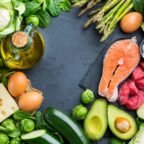Keto for Beginners: Top 10 Tips to Ensure Your Success
Starting the ketogenic (keto) diet can feel overwhelming for beginners, but with the right knowledge and approach, you can set yourself up for long-term success. The keto diet focuses on high-fat, moderate-protein, and very low-carbohydrate foods, which encourages your body to enter a state called ketosis, where it burns fat for fuel instead of carbohydrates. While the transition may seem challenging at first, these top 10 tips will help you navigate the keto diet effectively and sustainably.
1. Understand the Basics of Keto
Why It’s Important:
Before diving into the keto lifestyle, it’s crucial to understand the macronutrient breakdown and how the diet works. The primary goal is to drastically reduce carbohydrate intake (usually to about 20-50 grams of net carbs per day), increase fat consumption (about 70-75% of your total calories), and eat a moderate amount of protein (around 20-25% of your daily intake).
Tip:
Do some research and familiarize yourself with what foods are keto-friendly and which ones should be avoided. For example:
- Keto-friendly: Avocados, eggs, meat, cheese, non-starchy vegetables (spinach, kale, cauliflower, zucchini), and healthy fats (olive oil, coconut oil, nuts).
- Avoid: Bread, pasta, rice, sugary foods, and most fruits.
2. Track Your Macros
Why It’s Important:
To achieve and maintain ketosis, you need to stay within your carb limit and get the right ratio of fat to protein. Tracking your macronutrients (carbs, fats, and proteins) is a key factor in your success.
Tip:
Use a food tracking app like MyFitnessPal or Carb Manager to monitor your daily intake and make sure you’re hitting your target ratios. Many people find it helpful to track their food for the first few weeks until it becomes second nature.
3. Stay Hydrated and Replace Electrolytes
Why It’s Important:
When starting keto, your body flushes out a lot of water and electrolytes. This can lead to dehydration and the “keto flu”, which includes symptoms like headache, fatigue, and dizziness. Replenishing lost electrolytes (sodium, potassium, magnesium) is crucial for preventing these symptoms and feeling your best.
Tip:
- Drink plenty of water: Aim for at least 8 cups of water per day.
- Replenish electrolytes: Consider adding a pinch of Himalayan salt to your meals, drinking bone broth, or using an electrolyte supplement to replace sodium, potassium, and magnesium. Foods like avocados, leafy greens, and nuts also help replenish electrolytes.
4. Meal Prep for Success
Why It’s Important:
One of the most challenging aspects of sticking to keto is finding quick and easy meals. Meal prepping not only saves time but also helps you avoid temptation when hunger strikes. Having pre-prepared keto-friendly meals and snacks ensures you’re always ready.
Tip:
Plan your meals ahead of time and spend a couple of hours on the weekend cooking. Prepare portions of your favorite keto dishes, such as grilled chicken, roasted vegetables, and salads, in advance. Store them in airtight containers to make it easier to grab a meal when you’re busy.
5. Don’t Be Afraid of Healthy Fats
Why It’s Important:
On the keto diet, fats should make up the majority of your calorie intake. However, many people fear eating too much fat because of misconceptions about fat contributing to weight gain. In reality, the right fats are essential for ketosis and help with satiety, energy, and overall health.
Tip:
Incorporate healthy fats into every meal. These include:
- Avocados
- Grass-fed butter or ghee
- Coconut oil
- Olive oil
- Full-fat dairy (cheese, heavy cream, etc.)
- Fatty fish like salmon
6. Avoid “Hidden” Carbs
Why It’s Important:
Many seemingly low-carb foods can contain hidden carbs that can quickly add up and push you out of ketosis. It’s easy to overlook certain foods like sauces, salad dressings, or packaged “low-carb” products that still contain significant amounts of sugar or starch.
Tip:
Always read labels carefully, even for foods that seem keto-friendly. Pay attention to net carbs, which are calculated by subtracting fiber and sugar alcohols from total carbs. This will give you a better understanding of how many digestible carbs you’re actually consuming.
7. Learn to Handle Keto Cravings
Why It’s Important:
During the transition to keto, cravings for carbs and sugar can be intense. Your body is adjusting to a new source of energy (fat), and these cravings are often a sign of carb withdrawal. The good news is that they tend to subside after a few days or weeks.
Tip:
- Eat plenty of fat: Eating more fat will keep you full and satisfied, reducing hunger and cravings.
- Have keto-friendly snacks ready: Stock up on snacks like cheese, nuts, or hard-boiled eggs to prevent reaching for carb-heavy options when cravings hit.
- Stay distracted: When cravings strike, try to engage in an activity to keep your mind off food—take a walk, read, or do something you enjoy.
8. Gradually Transition Into Keto
Why It’s Important:
Going from a high-carb diet to a strict keto diet can be a shock to your system. For some, this sudden change can result in fatigue, headaches, or irritability. To make the transition smoother, it’s better to ease into the diet gradually.
Tip:
Consider reducing carbs gradually over the course of 1-2 weeks. This will allow your body to adjust more easily and can help minimize symptoms of the “keto flu.” You can start by eliminating processed carbs and gradually reducing fruits, grains, and starchy vegetables.
9. Exercise to Boost Your Results
Why It’s Important:
Exercise can help accelerate your progress on the keto diet by increasing fat loss, improving energy, and supporting muscle preservation. While you don’t need to exercise excessively to see results, adding physical activity to your routine can enhance the benefits of keto.
Tip:
Focus on low-intensity workouts at first, like walking or light resistance training. Once you’re fully adapted to keto, you may also want to try higher-intensity workouts like HIIT, which can help further burn fat.
10. Be Patient and Consistent
Why It’s Important:
The keto diet is a long-term commitment, and it takes time for your body to fully adjust to burning fat for fuel. Many beginners expect rapid weight loss within the first few days, but results can vary. Weight loss and health benefits often come gradually, and patience is key.
Tip:
Track your progress using metrics other than the scale, such as how you feel, energy levels, and body measurements. Focus on consistent habits, and trust the process. Keto isn’t a quick fix—it’s a sustainable lifestyle change.
Conclusion
The ketogenic diet can offer incredible health benefits, including weight loss, improved mental clarity, and increased energy levels. By following these top 10 tips, you’ll be well on your way to achieving success and making keto a sustainable part of your life.
Remember, starting slow, tracking your macros, staying hydrated, and being consistent are the keys to long-term success. With the right mindset and planning, you can thrive on the keto diet and enjoy all of its benefits!































